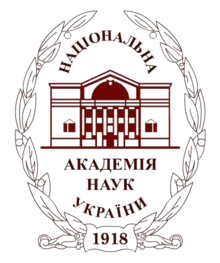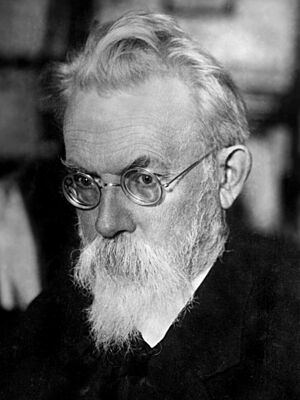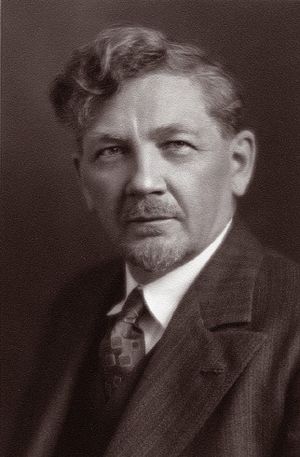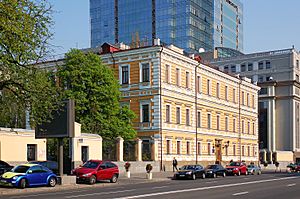National Academy of Sciences of Ukraine facts for kids
 |
|
| Formation | November 27, 1918 (official date and the first General Assembly)
November 14, 1918 (signing of the law by the Hetman of Ukraine) |
|---|---|
| Headquarters | Kyiv, Ukraine |
|
Chairman
|
Anatoliy Zahorodniy |
The National Academy of Sciences of Ukraine (NASU) is a very important organization in Ukraine. It helps develop science and technology by bringing together many research institutes across the country. It's the main group for scientific research in Ukraine, working alongside five other academies that focus on different science areas.
The NASU has many different parts, like departments, research institutes, and science centers. Every year, the Academy shares its progress with the Cabinet of Ministers of Ukraine, which is like the government's main team. The main office of the Academy is in Kyiv, Ukraine.
From 1919 to 1991, the NASU was part of the Academy of Sciences of the Soviet Union.
Contents
Names Through the Years
The National Academy of Sciences of Ukraine has had five different names since it started.
| Names for the Academy | Native language | dates |
|---|---|---|
| Ukrainian Academy of Sciences | Українська академія наук | 1918—1921 |
| All-Ukrainian Academy of Sciences | Всеукраїнська академія наук | 1921—1936 |
| Academy of Sciences of the UkrSSR | Академія наук Української РСР | 1936—1991 |
| Academy of Sciences of Ukraine | Академія наук України | 1991—1993 |
| National Academy of Sciences of Ukraine | Національна академія наук України | since 1994 |
How the Academy Started
Early Ideas and Founding
Before the NASU was created, there were other science groups in Ukraine. One was the Ukrainian Scientific Society in Kyiv, and another was the Shevchenko Scientific Society in Lemberg (now Lviv). These groups helped set the stage for a national academy.
The idea for the Academy came from the Ukrainian Science Society in April 1917. The Academy officially began during the time of the first Ukrainian State. Mykola Vasylenko, who was the Minister of Education and Arts, suggested forming a special group to plan it.
This group was led by Volodymyr Vernadskyi, a well-known scientist. They created a plan to start a Ukrainian Academy of Science in Kyiv, along with a National Library and a National Museum. By November 14, 1918, the law to establish the Ukrainian Academy of Sciences was officially signed. This law also approved the Academy's rules, staff, and institutions. It named the first 12 full members, called academicians.
What the First Academy Looked Like
The first Academy had three main research areas:
- History and language
- Physics and mathematics
- Social studies
It also planned to have many different parts, like 15 institutes, 14 permanent groups, 6 museums, and a national library. All publications from the Academy were meant to be in the Ukrainian language. The rules also said that scientists from all over Ukraine, and even foreign scientists, could become members.
The first leaders and members of the Academy were chosen by the Ukrainian government. Future members would be elected by the existing academicians. Some of the first members included historians, economists, linguists, geologists, and biologists.
Pavlo Skoropadsky, who was the head of the Ukrainian State, asked Mykhailo Hrushevsky to be the first President of the Academy. Hrushevsky was a famous historian, but he turned down the offer. Later, he became a very important figure in the Academy.
The Academy officially started its work at the end of November 1918. On November 27, 1918, Volodymyr Vernadsky was chosen as the first President, and Ahathanhel Krymsky became the permanent secretary.
Some of the first groups created in December 1918 included:
- A group to create a history and geography dictionary of Ukraine.
- A group to create a history dictionary of the Ukrainian language.
- An institute for technical mechanics, led by Stepan Tymoshenko.
- An institute for economic studies.
More groups were added the next month, focusing on things like population studies and common law.
Challenges in the Early Years
The Academy faced many challenges in its first few years because of political problems and wars in Ukraine. The leaders of the Academy tried to keep it focused on science and not get involved in politics. Even with money problems, hunger, and some members leaving, the Academy managed to survive and grow. It started to publish its scientific work.
In January 1919, the government made some changes to the Academy's rules. They said that publications could be in Ukrainian or other languages, but most had to be in Ukrainian. All Academy officials also had to speak Ukrainian.
In February 1919, the Academy was given a large building in Kyiv, which used to be a boarding house. This building became its main home. For many years, this date was considered the start of the Academy, even though the law creating it was signed earlier.
After more political changes, Volodymyr Vernadsky resigned as President. Other scientists like Orest Levytsky and Volodymyr Lypsky took on the role. Between 1919 and 1930, 103 new academicians were elected.
By the late 1920s, the Soviet authorities took more control over the Academy. In 1921, the Academy was renamed the All-Ukrainian Academy of Sciences (VUAN). This name showed its goal to unite scientists from all Ukrainian lands, even those outside Soviet Ukraine. However, relationships with Ukrainian scientists abroad became difficult.
Leaders of the Academy
Presidents
|
Chief Scientific Secretaries
|
||||||||||||||||||||||||||||||||||||||||||
How the Academy Works Today
The National Academy of Sciences of Ukraine is a self-governing organization. This means it can decide its own research topics, how to organize its work, manage its money, and choose its scientists. It also handles its own international science connections.
Leadership and Structure
The highest decision-making body is the General Assembly. This group includes all full members (academicians) and corresponding members. Scientists from the Academy's research institutions also take part in important decisions.
Between General Assembly meetings, the Academy is managed by the National Academy of Sciences of Ukraine Presidium. This group is elected every five years. The Presidium meets in the historic building that the Academy has owned since 1918.
The NASU has 3 main sections, which are divided into 14 departments. There are also 6 regional science centers in different parts of Ukraine. The main parts of the NASU are its scientific research institutes and other science places like observatories, botanic gardens, and libraries.
In 2006, the Academy had over 43,000 employees, including more than 16,000 researchers. Many of these researchers had advanced degrees.
The NASU is responsible for most of the important scientific discoveries made in Ukraine. This includes things like changing lithium into helium, making heavy water, and developing a special 3-D radar.
Main Science Sections
- Section of Physical-Technical and Mathematical Sciences
- Department of Mathematics
- Department of Computer Science
- Department of Mechanics
- Department of Physics and Astronomy
- Department of Earth Sciences
- Department of Physical and Technical Problems of Materials Science
- Department of Physical and Technical Problems of Power Engineering
- Department of Nuclear Physics and Power Engineering
- Section of Chemical and Biological Sciences
- Department of Chemistry
- Department of Biochemistry, Physiology and Molecular Biology
- Department of General Biology
- Section of Social Sciences and Humanities
- Department of Economics
- Department of History, Philosophy and Law
- Department of Literature, Language and Art Studies
Regional Science Centers
The Academy has science centers in different regions:
- Donetsk SC (now in Kramatorsk) - 9 research institutes.
- Western SC (Lviv) - 18 institutes.
- Southern SC (Odesa) - 7 institutes.
- North-East SC (Kharkiv) - 17 institutes.
- Dnieper SC (Dnipro) - 7 institutes.
- Crimea SC (Simferopol) - 8 institutes (their work has been paused since 2014).
Most of the Academy's institutions (212) are in Kyiv. Other cities like Kharkiv (39) and Lviv (27) also have many. The Academy has at least one institution in most regions of Ukraine.
Important Institutions
Libraries
The NASU has two national libraries:
- The Vernadsky National Library of Ukraine, which has 10 million books and old writings.
- The Stefanyk National Science Library in Lviv.
Parks and Nature Reserves
The Department of General Biology manages several parks and nature reserves:
- Trostianets dendro-park
- Donetsk Botanic Garden
- Danube Biosphere Preserve
- Karadah Nature Preserve
- Kryvyi Rih Botanic Garden
- Luhansk Nature Preserve
- M.M. Gryshko National Botanical Garden
- Oleksandriya dendro-park
- Sofiyivka dendro-park
- Ukrainian Steppe Nature Preserve
- Black Sea Biosphere Reserve
Publishers
The NASU has its own publishing houses. Until 2024, it had Naukova Dumka ("Scientific Thought"). Since 2001, it also has Akademperiodyka ("Academic Periodical"), which took over all publishing activities in 2024.
Awards and Recognition
Bogoliubov Prize
The Bogoliubov Prize is given by the National Academy to scientists who have made amazing contributions to theoretical physics and applied mathematics. This award honors the famous physicist and mathematician Nikolay Bogoliubov. It started in 1992.
Past Winners
- 2004 — Anton Naumovets
- 2002 — Leonid A. Pastur and Sergiy Peletminsky
- 1998 — A. V. Pogorelov
- 1997 — Vasiliy S. Vladimirov
- 1996 — Vladimir A. Marchenko
- 1993 — Oleksandr Sharkovsky
- 1992 — Yurii Mitropolskiy
Vernadsky Gold Medal
Since 2004, the Academy has given its Vernadsky Gold Medal every year to its most outstanding academicians.
- 2003 Borys Paton
- 2004 Platon Kostiuk and Szilveszter E. Vizi
- 2005 Viktor Skopenko and Nikolai Plate
- 2006 Yurii Mitropolskiy and Yury Osipov
- 2007 Myroslav Popovych and Georges Nivat
- 2008 Viktor Baryakhtar and Vladimir Kadyshevsky
- 2009 Volodymyr Marchenko and Jean Bourgain
- 2010 Mikhail Lisitsa and Manuel Cardona
- 2011 Borys Oliynyk and Blaže Ristovski
- 2012 Mykola Bahrov and Nikolai Laverov
- 2013 Oleksandr Huz and Herbert Mang
- 2014 Vadym Loktev and Alexei Abrikosov
- 2015 Anthony Turner and Ganna V. Elska
- 2016 Valeriy Skorokhod and Giorgi Tavadze
- 2017 Volodymyr Morgun and George Fedak
- 2018 Oleksiy Onyschenko and Michael Moser
- 2019 Lukyan Anatychuk and Juri Grin
- 2020 Anton Naumovets and Anton Zeilinger
- 2022 Volodymyr Horbulin and Janusz Kacprzyk
- 2023 Aaron Ciechanover and Serhiy Komisarenko
Related Science Organizations
Other State-Funded Research Groups
- Institute for Problems of Cryobiology and Cryomedicine
- National Academy of Arts of Ukraine
- National Academy of Medical Sciences of Ukraine
- National Academy of Agrarian Sciences of Ukraine
- National Academy of Legal Sciences of Ukraine
- National Academy of Pedagogical Sciences of Ukraine
- Minor Academy of Sciences of Ukraine
University Connections
Kyiv Academic University (KAU) is a special research university in Ukraine. It was started in 2016 and is managed by both the National Academy and the Ministry of Education and Science of Ukraine.
KAU has 10 departments and 3 research centers. Some of its departments are:
- Department of Applied Physics and Material Science
- Department of Applied Physics and Nanoscale Systems
- Department of Fundamental Problems of General and Applied Physics
- Department of Biomedicine and Neuroscience
- Department of Theoretical and Mathematical Physics
- Department of Mathematics
- Department of Theoretical Cybernetics and Optimal Control Methods
- Department Molecular Biology and Biotechnology
KAU's main goals are to:
- Do scientific research with students.
- Teach students with top scientists from the NASU.
- Encourage new ideas and inventions.
- Help people keep learning about science.
Images for kids
-
The banknote of 1000 Hryvnias, 2019
See also
 In Spanish: Academia Nacional de Ciencias de Ucrania para niños
In Spanish: Academia Nacional de Ciencias de Ucrania para niños







